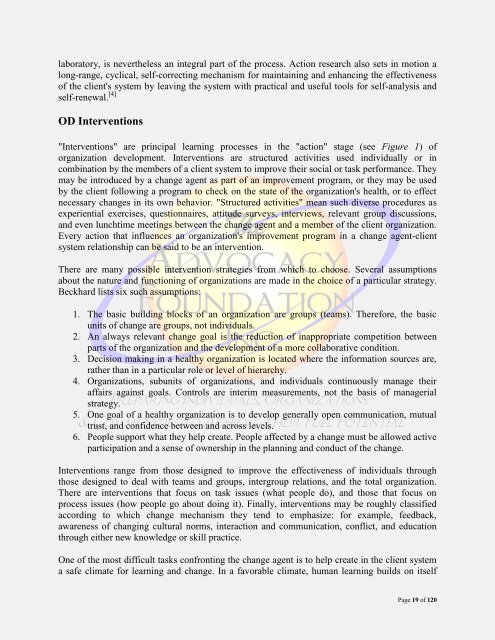Organizational Development - Vol. V, Part II
Organizational Development - Vol. V, Part II
Organizational Development - Vol. V, Part II
Create successful ePaper yourself
Turn your PDF publications into a flip-book with our unique Google optimized e-Paper software.
laboratory, is nevertheless an integral part of the process. Action research also sets in motion a<br />
long-range, cyclical, self-correcting mechanism for maintaining and enhancing the effectiveness<br />
of the client's system by leaving the system with practical and useful tools for self-analysis and<br />
self-renewal. [4]<br />
OD Interventions<br />
"Interventions" are principal learning processes in the "action" stage (see Figure 1) of<br />
organization development. Interventions are structured activities used individually or in<br />
combination by the members of a client system to improve their social or task performance. They<br />
may be introduced by a change agent as part of an improvement program, or they may be used<br />
by the client following a program to check on the state of the organization's health, or to effect<br />
necessary changes in its own behavior. "Structured activities" mean such diverse procedures as<br />
experiential exercises, questionnaires, attitude surveys, interviews, relevant group discussions,<br />
and even lunchtime meetings between the change agent and a member of the client organization.<br />
Every action that influences an organization's improvement program in a change agent-client<br />
system relationship can be said to be an intervention.<br />
There are many possible intervention strategies from which to choose. Several assumptions<br />
about the nature and functioning of organizations are made in the choice of a particular strategy.<br />
Beckhard lists six such assumptions:<br />
1. The basic building blocks of an organization are groups (teams). Therefore, the basic<br />
units of change are groups, not individuals.<br />
2. An always relevant change goal is the reduction of inappropriate competition between<br />
parts of the organization and the development of a more collaborative condition.<br />
3. Decision making in a healthy organization is located where the information sources are,<br />
rather than in a particular role or level of hierarchy.<br />
4. Organizations, subunits of organizations, and individuals continuously manage their<br />
affairs against goals. Controls are interim measurements, not the basis of managerial<br />
strategy.<br />
5. One goal of a healthy organization is to develop generally open communication, mutual<br />
trust, and confidence between and across levels.<br />
6. People support what they help create. People affected by a change must be allowed active<br />
participation and a sense of ownership in the planning and conduct of the change.<br />
Interventions range from those designed to improve the effectiveness of individuals through<br />
those designed to deal with teams and groups, intergroup relations, and the total organization.<br />
There are interventions that focus on task issues (what people do), and those that focus on<br />
process issues (how people go about doing it). Finally, interventions may be roughly classified<br />
according to which change mechanism they tend to emphasize: for example, feedback,<br />
awareness of changing cultural norms, interaction and communication, conflict, and education<br />
through either new knowledge or skill practice.<br />
One of the most difficult tasks confronting the change agent is to help create in the client system<br />
a safe climate for learning and change. In a favorable climate, human learning builds on itself<br />
Page 19 of 120

















